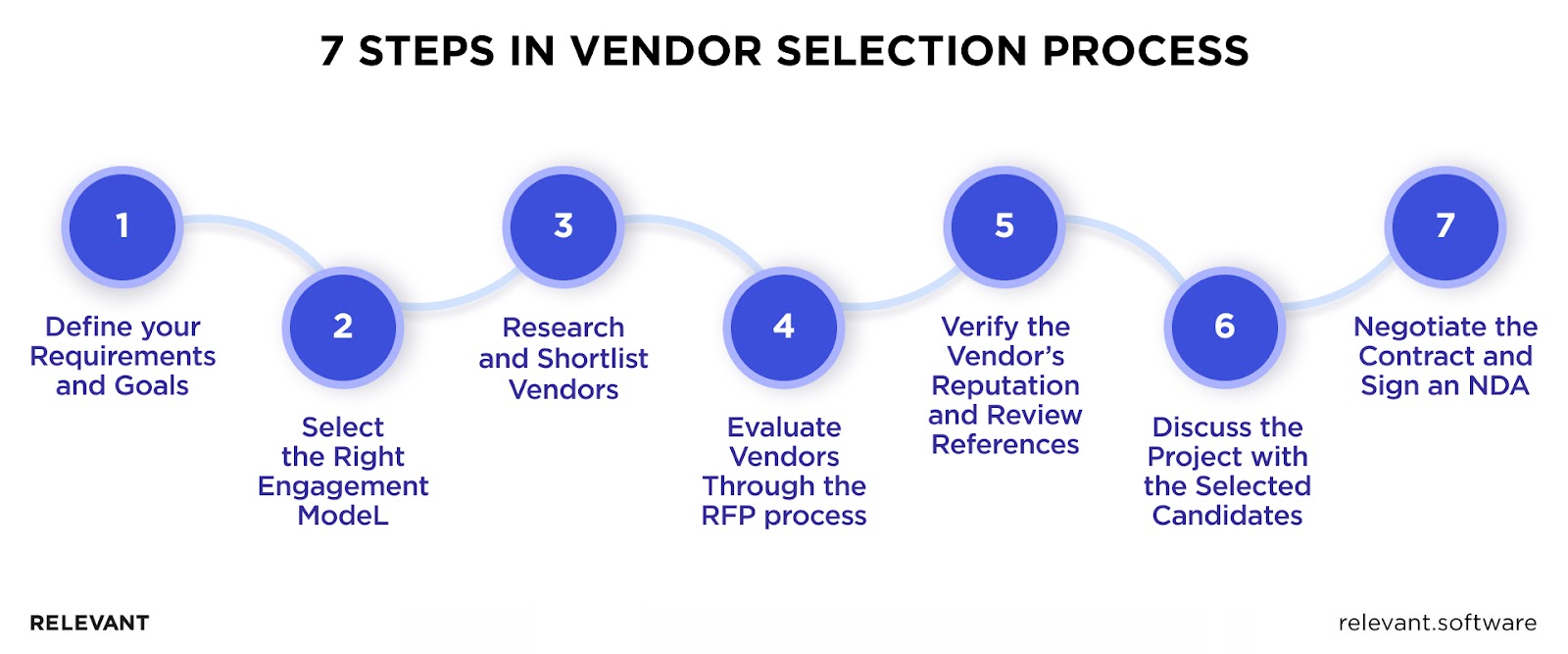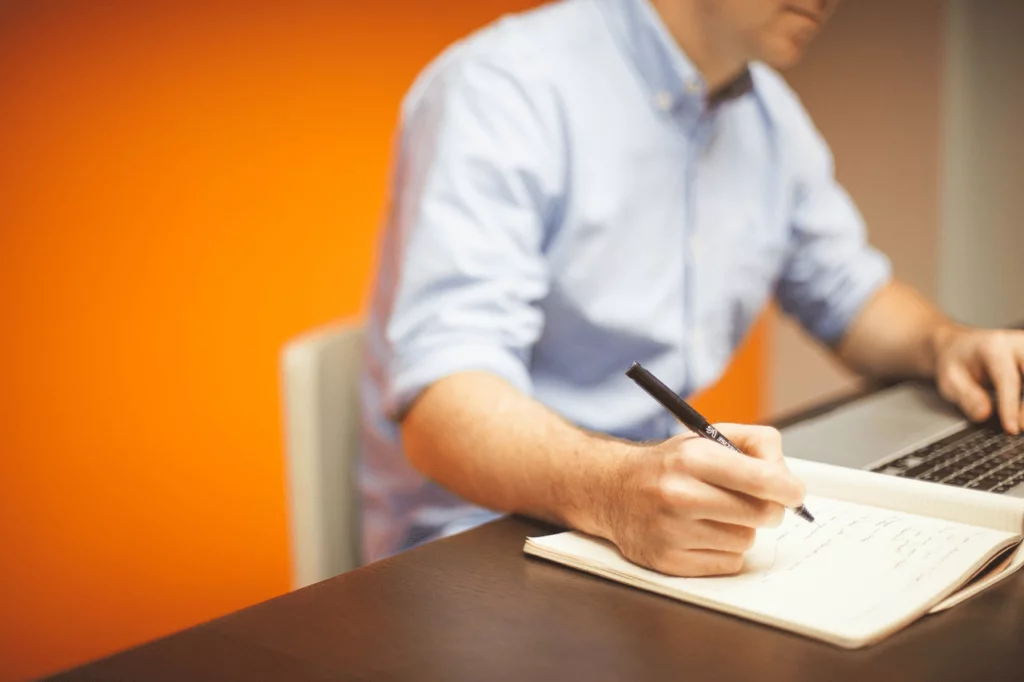Software Outsourcing Vendor Selection Process and Criteria
Updated: June 4, 2025
Are you looking for an outsourcing software development company but feeling overwhelmed by the many options available? Vendor selection can be daunting as many providers showcase attractive websites and boast big-name clients.
Regrettably, it’s too common for a company to be drawn in by an impressive facade only to receive a low-quality product in return. The end result can be frustrating and costly, whether it’s buggy code, the wrong software implementation, or improper integration. Sometimes, a system may appear to be functioning smoothly at first, but it quickly becomes clear that it’s not flexible enough to accommodate new features or is difficult to maintain.

We provide companies with senior tech talent and product development expertise to build world-class software. Let's talk about how we can help you.
Contact usAt Relevant, we’ve had the opportunity to work with clients who have faced such challenges. Sometimes, they ask us to fix software created by other vendors. However, it’s been easier to rebuild the system from the ground up due to underlying architectural issues.
To ensure you don’t end up in such a situation, we have compiled a checklist of vendor selection criteria to help guide you. We want your software vendor evaluation strategy to be well-thought-out, comprehensive, and prudent, considering all possible factors while prioritizing long-term investment returns.
Table of Contents
What are Vendor Selection Criteria?
So, you need to select a software development outsourcing company that is proficient and committed to delivering a top-quality, reliable, and maintainable product. To ensure success, it’s crucial to establish a clear set of vendor selection criteria. The IT vendor selection process can quickly become a wild goose chase without these.
De facto, vendor selection criteria are the set of guidelines or parameters used to evaluate and choose a performer for a particular product or service. To evaluate vendors, businesses typically contact references and apply a vendor selection criteria checklist to ensure they meet specific requirements and needs.
Why are Vendor Selection Criteria Essential?
These criteria for vendor selection are crucial for several reasons. Firstly, they enable businesses to evaluate potential IT vendors based on specific requirements and needs. This helps you to choose a vendor that has the capability to provide the required software products or services to achieve your objectives.
Secondly, the software vendor selection process enables businesses to compare contenders based on various factors such as cost, quality, experience, reliability, support, and more. By evaluating vendors based on these criteria, you can make informed decisions and select the partner that best fulfills your needs and budget.

Thirdly, IT vendor selection criteria provide a standard framework for evaluating vendors. By using a consistent set of criteria, you can ensure that you compare apples to apples and avoid getting sidetracked by irrelevant factors.
Lastly, these criteria help mitigate risks associated with selecting the wrong vendor. By evaluating vendors based on their reputation, track record, and technical expertise, you minimize the risk of choosing a vendor that may deliver poor-quality products or services or fail to meet deadlines.
7 Major Steps in Vendor Selection Process
The vendor selection process involves several steps, including identifying potential vendors and obtaining quotes or proposals with competitive bids. Here we outline a definitive sequence of measures that must be taken:

1. Define your Requirements and Goals
To understand your project better and set yourself up for success, you should take several key steps before beginning the vendor selection process.
- To begin with, you need to define the type of project you’re undertaking. Is it a minimum viable product (MVP), a simple solution with a set of features, or a more complex software with evolving requirements? Knowing this will help you determine what kind of vendor you need and what to look for during the software selection process.
- Next, you should evaluate the scope of your project. What is the end goal of your product, and what questions do you need to discuss with potential vendors? Additionally, consider the staff and equipment required for successful app development.
- Also, you’ll need to estimate your project budget. For small projects with clearly defined requirements, budgeting is relatively straightforward. However, for larger projects with evolving requirements, budgeting can be a more complex process that requires ongoing evaluation and adjustment.
- Additionally, you must establish clear and realistic deadlines for the project. When choosing a vendor, it’s necessary to ensure that they have a proven track record of meeting deadlines and delivering high-quality work on time.
- Finally, select a software development process model that aligns with your project goals and requirements – waterfall, incremental, agile, RAD, or other. Each model has its unique working style and set of activities, so choosing the one that best fits your project needs is crucial.
2. Select the Right Engagement Model
The IT sector presents numerous engagement approaches, and it’s essential to select the most appropriate model according to your project’s distinct features, such as scale, duration, objectives, and concept.
- Dedicated Team: The model provides clients with a long-term partnership, where the IT vendor is responsible for hire dedicated development team and managing it, including workspace and daily workload management. The pricing system is based on monthly payments that cover salaries, vendor fees, and administrative costs.
- Staff Augmentation (Outstaffing): This business model involves employees working for a client company while remaining on the payroll of an external service provider. In essence, the client company “leases” the services of these employees from the provider, paying a fee for each team member.
- Fixed Price: It is a project-based pricing approach that determines the project’s scope, work schedule, and cost before actual development begins. The vendor provides a client with a fixed price offer and a payment schedule based on the project’s stages and duration.
- Time & Material: It is a billing model where the client is charged based on the daily rate of each specialist involved in the project. Detailed project reports are provided with each invoice to keep the client informed of the work progress.
It’s crucial to carefully consider and choose the engagement model that aligns with your needs, as it can significantly impact the project’s cost. By the way, in this guide, we’ve meticulously compared various types of outsourcing models. Feel free to take a look!
3. Research and Shortlist Vendors
Once the management has prepared the necessary deliverables, you can begin looking for a suitable vendor. When choosing software development vendors, you can start with your networks, online search, or popular review platforms such as Clutch, GoodFirms or DesignRush. By filtering search results by service focus, technology, location, and price, you can easily narrow down your options and choose vendors that meet your unique requirements. Pay special attention to the main IT vendor selection criteria:

Expertise and Qualifications
When selecting a software outsourcing partner, their expertise and qualifications are the most significant factor to consider. Specify your tech stack and skill set requirements to narrow down your options. Focus on vendors specializing in technical skills positively impacting user experience and software quality. Look for providers who have successfully completed similar projects to yours.
Helpful tip: Avoid vendors who claim to be experts in all tech fields. Insist on working with specialists who match your technical requirements.
Industry Experience
It is just as crucial as technical knowledge. Vendors who have worked in your specific business vertical have subject-matter expertise that can be invaluable to your project. While a vendor can learn about your industry, it will take longer to get up to speed. To ramp up quickly, choose a vendor who already knows your domain and can hit the ground running.
Helpful tip: One effective way to assess their technical competence and industry experience is by examining their background, past and current clients, projects and case studies, specialist CVs, blog publications, and event attendance.
Company Size
The vendor’s size can impact their ability to scale the development team up or down. Medium and large vendors usually have more resources and a larger pool of external candidates. That can benefit projects requiring a larger team or more specialized skills. However, smaller vendors may provide more personalized attention and flexibility. Consider your project’s specific needs and choose a vendor accordingly.
Helpful tip: Ensure your outsourcing engagement represents at least 5% and no more than 20% of the vendor’s business base. This guideline called the “golden rule of 5%,” ensures you receive the attention you need to be successful.
Cost
When evaluating software outsourcing vendors, pricing is often a top consideration for many businesses. However, it’s important not to make price the sole determining factor in your decision-making process.
While cheaper initial rates may seem appealing, they could cost you more in the long run. It’s essential to keep in mind that lower rates are often associated with less experienced vendors. Working with such vendors can lead to longer product delivery times, poor testing and security, higher rates of bug fixing, and unprofessional app development.
Helpful tip: It’s crucial to balance pricing and quality. You should focus on finding a vendor with reasonable rates for high-quality work backed by a proven track record.
Location and Communication
When looking for an offshore partner, we recommend paying attention to the best outsourcing destinations described in detail here. But if the vendor’s location is not crucial to you, communication channels are still vital.
At a minimum, the vendor should provide you with a communication platform such as Skype or Slack; project development and progress tracking tools, such as Basecamp and Jira; and video conferencing apps like Zoom and Skype. Moreover, you need to ensure that the vendor has a strong command of the English language and excellent consulting skills to answer all your queries.
Helpful tip: If you are looking for an offshore vendor, take a look at Ukraine. This IT outsourcing destination ensures you invest soundly in your business’s future.
If you need more information from potential vendors to help you narrow down your list, consider issuing a “Request for Information” (RfI). That can help you better understand each vendor’s expertise and qualifications. By performing due diligence and research, you can build a shortlist of vendors that meet your criteria and are worthy of your attention.

4. Evaluate Vendors Through the RFP process
Once you have identified a shortlist of potential vendors based on your requirements, you can take different approaches to engage a vendor. One method is to convey your project vision, highlighting the main goals and key features you want to incorporate into your software.
Another method includes preparing a detailed request for proposal (RFP) that helps attract more suitable responses and facilitates an apples-to-apples comparison of the vendors. Your RFP software should include the following elements:
- A detailed description of your project requirements and goals
- The scope of work and specific deliverables you expect from
- The project timeline and any milestones
- The budget or budget range for the project
- Any technical requirements or constraints
- Any relevant policies or regulations that vendors should be aware of
- Instructions on how to respond and what information should be included in the proposal
By the by, you can find a template and tips for creating an RFP here.
5. Verify the Vendor’s Reputation and Review References
As the potential vendors submit their RFPs, it’s crucial for the team responsible for vendor and software selection to come together and evaluate each proposal. In addition to reviewing the RFPs, the team should verify any company details and conduct thorough research on each vendor’s track record, project completion rate, and customer feedback.
It is now a common practice to request references, and most companies are open to sharing their experiences without revealing confidential information. Feel free to approach a potential software company asking for contact information for product owners, project managers, or senior executives from their past and current clients. Their feedback could provide valuable insights into the vendor’s work processes, communication style, service quality, and cultural nuances.
We strongly advise conducting a thorough examination of vendor profiles. It’s essential not to fixate solely on ratings! Take the time to read complete reviews, and pay extra attention to those that include negative evaluations. They could provide valuable insights to ponder upon.
6. Discuss the Project with the Selected Candidates
To better understand each supplier, we recommend conducting an hour-long interview with each of them. This will allow you to evaluate how well you can communicate with each other and learn about their past experiences, workflows, and completed projects.
A trustworthy software development provider will be enthusiastic about demonstrating their technical capabilities and offering optimal solutions for your project. It’s advisable to conduct technical interviews with developers assigned to your project, assessing both their hard skills and compatibility. If your organization lacks technical knowledge, consider engaging a reliable third-party expert.
After a series of interviews, you will have a few top candidates. (Having more than one great vendor to choose from can be good as it gives you options and a backup plan in case your first choice doesn’t work out.) It’s not uncommon to find that these vendors have similar qualifications and offerings. In this scenario, factors such as pricing and overall impression of the vendor may play a critical role in making the final decision.
7. Negotiate the Contract and Sign an NDA
After selecting a vendor for software outsourcing, safeguarding your intellectual property and confidential information becomes a top priority. For this, the following documents are usually signed:
- Non-Disclosure Agreement (NDA): Protects any sensitive or proprietary information shared between you and your vendor from being disclosed to outsiders.
- IP Rights: Ensure ownership of code, product, designs, and documentation with a clear agreement with the vendor.
- Non-Employment Agreement (NEA): Prevent the hiring of each other’s employees under a non-employment agreement.
- Data privacy: Guarantee the safety and security of your data with the vendor during all project stages, including exchange and storage.
There are other documents on software development outsourcing that you might be interested in. Signing them ensures that your business is fully protected and your partnership is built on trust and mutual understanding.
Why Choose Relevant Software as Your Development Partner?
When it comes to long-term partnering with an IT outsourcing services company, thorough research is critical to ensure that you minimize cost, prevent future misunderstandings, and avoid hidden project management errors. Although evaluating potential vendors can seem tedious, it is time well spent, and this guide provides a practical and efficient way to do so. After all, you don’t want to rush into a partnership blindly; as the old saying goes, “look before you leap.”
Those clients who have dedicated their time and effort to software vendor evaluation to create the best product for their business will attest that it was worth it. At Relevant, we can help you become one of those success stories.
As an outsourcing provider of product design, development, and staff augmentation services (among others), we are equipped to identify, refine, and implement the best software to help your business grow. Contact us today to get started.
Our core services:
Do you want a price estimate for your project?
Do you know that we helped 200+ companies build web/mobile apps and scale dev teams?
Let's talk about your engineering needs.
Write to us











